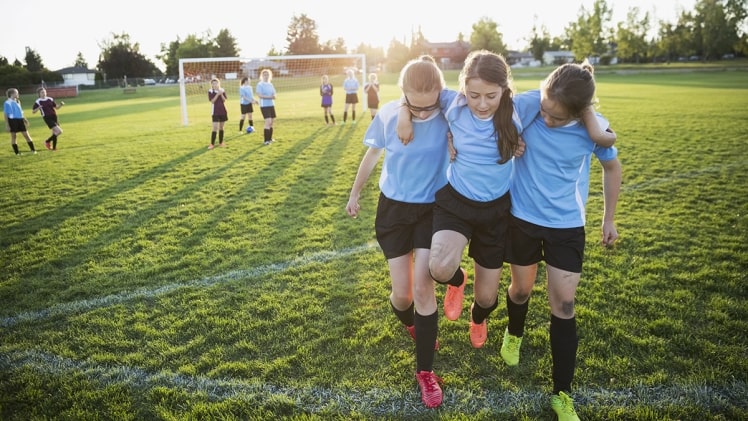Many children consider sports an important part of their lives. Although individual and team sports offer many benefits, there are also risks. The Centers for Illness Control and Deterrence reports that more than half of all sports-related injuries and illnesses reported each year are continued by children between the ages of 5 and 24.
No surprise that children are prone to injuries. Their bodies are still in development, which can cause problems with coordination. According to the CDC, lower limit injuries (42%) are more common than upper limit injuries (30%).
Younger children are more focused on a particular sport than cross-training. This could lead to them getting more injuries. Participating in youth sports can lead to injuries.
What are the most common sports injuries in children?
There is always a chance that your child will get hurt in sports. While there are some things you can do, it’s not possible to prevent all injuries. While injuries can vary depending on the sport, skinned knees and minor abrasions are the most public injuries in children. Sprains are next.
When you look at injuries from sports, the types and severity of those injuries often reflect the demands of the sport. For example, in soccer, we see more wounds to the knees and ankles like ankle sprains or ACL tears. Swimming is a sport where the bears are heavily recruited and more likely to be injured. Check out NetBet Sport for all your sports betting needs.
These injuries are usually minor and can take days, if not weeks, to fully recover. Let’s take an in-depth look at some of the most mutual injuries to sports for kids.
Ankle Sprains
A sprain can occur when the ankle’s supporting ligaments are stretched and torn. This happens when someone runs, jumps, or changes direction quickly, like while playing netball, basketball, or soccer.
“Children have more ligamentous flexibility, which means that their ligaments that hold their frames together are looser and stretchier. This causes their ankles to become looser, and other joints in their bodies, which can lead to injuries like a sprain.
ACL Injury
An ACL injury is a tear in the forward cruciate or stabilizing ligament of your knee. An ACL injury involves the forward cruciate ligament or the stabilizing ligament of your knee.
ACL tears are most commonly caused by a non-contact injury. This is when an athlete’s knee twists while pivoting, changing directions, landing from a jump or hyperextends. It can also be caused by a hit to the knee by another player or object. A child might feel or hear a “pop” in their knees at the time of the tear. The knee may swell up and make it difficult to walk and bend the knee fully.
Concussion
Concussions are common in all sports, but they are more common in soccer, hockey, rugby and soccer. These brain injuries are caused by an impact on the head. They can lead to serious complications.
A CDC study found that youth challenge football players aged 6-14 suffered 15 eras more head injuries during a practice or game than flag football players, and 23 times more severe head impacts.
Knee Pain
Knee pain can be caused by runner’s knee (patellofemoral painful syndrome) or Osgood Schlatter disease. This condition occurs below the knee joint due to the overuse of growth plates. Knee pain can result from overuse or acute trauma. This could be due to tightness or tracking in the quadriceps muscles or tracking of the kneecap.
Little League Injuries
Little league elbow is an injury to the elbow that results from repetitive throwing. It’s more common in pitchers but can affect any young athlete who throws often.
Little League shoulder is similar to Little League elbow. It occurs when an athlete throws too often or has poor technique.
Shin Splints
Shin splints are additional common injury in sports. Shin splints are technically known as medial tibial stress condition. This injury causes inflammation at the outside edge of the shin bone. It is most common among athletes who track a lot.
Vertebral stress fragments
Vertebral stress fractures, also known as spondylolysis or spondylolysis are found in the backbone and can cause back pain after certain activities such as running, dancing and gymnastics.
How can you prevent sports injuries?
Sports injuries are a serious matter of prevention. You can help reduce the chances of your child being injured on the field by taking a few preventative steps.
Make sure you have the right safety equipment
Following safety rules and correctly using safety equipment can reduce the chance of injuries and accidents. Proper tackle methods and helmet gear can help to prevent concussions in football players. You can find the right equipment for your child’s sport by talking to their coach or doing a quick Google search.
Do a pre-season assessment
Before the season begins, your child should visit their pediatrician. This is an chance for children to evaluate their strengths and to seek leadership from trainers and therapists in preparation for the season. A sports physical is usually required before your child can play the sport.
Cross Training
A child could play on multiple soccer teams throughout the year, with their seasons meeting each other. This has led to an upsurge in overuse injuries in younger children. To avoid injury to their growing bodies, I recommend that your child play many sports. Remember that growing bodies require rest.
Stretching
Children need to be flexible as they reach their growth spurts early in youth. Children’s bones tend to grow faster than their muscles and tendons can stretch, which leaves them with limited flexibility in their joints around puberty. This puts more strain on their bodies and can result in overuse injuries to their joints like the knee or ankle.
What should I do if my child sustains a sports injury?
Your child may get hurt playing sports. Make sure your child feels comfortable. This might involve icing, wrapping the injured limb, or cleaning the wound. It may also mean that your child shouldn’t be throwing if he or she is a pitcher.
Remember the abbreviation RICE which stands for rest, ice, compression, and elevation. These simple steps can be helpful in your child’s recovery after a strain or sprain, as well as any other similar injuries.
You may essential to see a doctor depending on how severe the injury is. If your child falls while running the headquarters, and has a damaged limb or is limping afterward, you should visit an urgent care center or emergency room to get X-rays taken immediately. A sports physician should be seen if a pitcher experiences pain while throwing, but not immediately.
It’s best to get medical attention if you’re not confident with your assessment and treatment of your child for a seemingly minor injury. Sometimes a blocked finger is not a jammed one. It can also be a fracture. Sometimes, deep cuts and lacerations will require sutures. These should be treated promptly.
If your child refuses to walk or use a limb or is having trouble with their headaches, it’s time for a medical evaluation. A head injury can lead to vision and behavior changes that could be indicative of a concussion. It is worth talking with a doctor.
Another thing to look out for is their ability to change and feel their fingers and toes. If this is compromised, it could indicate a neurologic impairment. For pain control, it is recommended that your child has an ace bandage and an ice pack. However, a pack of frozen vegetables can also be used.
Conclusion
Common sports injuries for kids include concussions, ankle sprains, and knee pain. These injuries can be prevented by ensuring your child exercises regularly, is careful with safety equipment, and has plenty of rest.
Many sports injuries can be treated using RICE (rest ice, compression and elevation). Sometimes, however, home treatment won’t be enough and your child will need to visit a healthcare provider.

